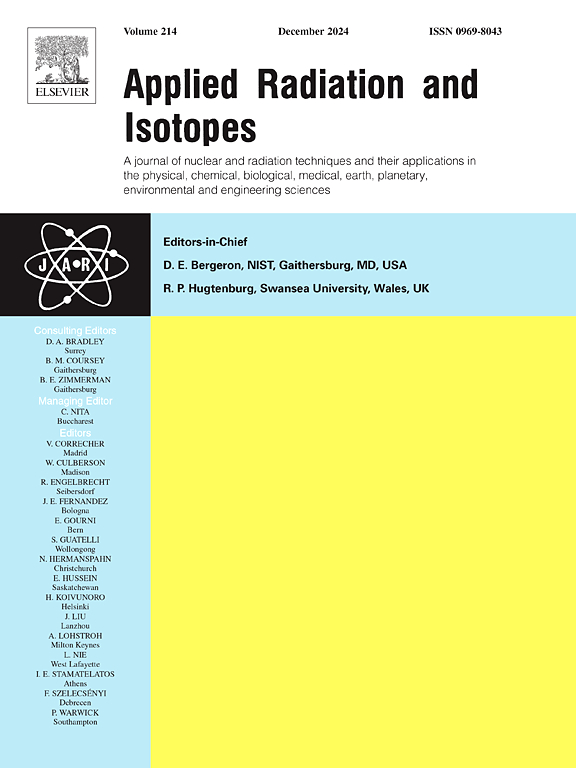Accuracy of 177Lu activity quantification using MCNP5-Modeled SPECT imaging
IF 1.6
3区 工程技术
Q3 CHEMISTRY, INORGANIC & NUCLEAR
引用次数: 0
Abstract
The present study was conducted to assess the accuracy of 177Lu quantification using Monte Carlo N-Particle Transport Code, Version 5 MCNP5. The developed code was verified against calibration factor (CF) measured experimentally. The CF for converting SPECT data into units of activity concentration was determined by modeling two phantom configurations: (1) a uniform 177Lu concentration of 5.3600 ± 0.0005 MBq/mL in 20 mL Petri dish, resulting in a CF1 of 12.5 ± 1.5 cps/MBq, and (2) a 65.4 mL radioactive sphere (5.0 cm diameter) within a non-radioactive background in a cylindrical Jaszczak phantom, yielding a CF2 of 16.0 ± 2.0 cps/MBq. The significant difference between CF1 and CF2 (21.26 %) highlights the impact of phantom size and geometry on the calibration process. The quantification error was evaluated using recovery coefficient (RC) of the spherical inserts in a NEMA phantom. The established CFs and RCs provide a reliable framework for accurate activity quantification in 177Lu SPECT imaging using the established MCNP5 code. Our findings suggest that MCNP5 simulations can effectively model the SPECT imaging process, accounting for factors such as photon attenuation and scatter, offering the potential for improved dosimetry calculations in radionuclide therapy.
使用mcnp5模型SPECT成像定量177Lu活性的准确性
本研究利用蒙特卡罗n粒子输运码(Monte Carlo N-Particle Transport Code, Version 5 MCNP5)评估177Lu定量的准确性。所开发的代码与实验测量的校准因子(CF)进行了验证。将SPECT数据转换为活性浓度单位的CF通过模拟两种幻影配置来确定:(1)在20 mL培养皿中均匀的177Lu浓度为5.3600±0.0005 MBq/mL, CF1为12.5±1.5 cps/MBq;(2)在圆柱形Jaszczak幻影中非放射性背景下的65.4 mL放射性球体(直径5.0 cm), CF2为16.0±2.0 cps/MBq。CF1和CF2之间的显著差异(21.26%)突出了模体尺寸和几何形状对校准过程的影响。利用NEMA模体中球面刀片的恢复系数(RC)对定量误差进行了评价。已建立的CFs和rc为使用已建立的MCNP5代码对177Lu SPECT成像进行准确的活性量化提供了可靠的框架。我们的研究结果表明,MCNP5模拟可以有效地模拟SPECT成像过程,考虑光子衰减和散射等因素,为改进放射性核素治疗中的剂量学计算提供了潜力。
本文章由计算机程序翻译,如有差异,请以英文原文为准。
求助全文
约1分钟内获得全文
求助全文
来源期刊

Applied Radiation and Isotopes
工程技术-核科学技术
CiteScore
3.00
自引率
12.50%
发文量
406
审稿时长
13.5 months
期刊介绍:
Applied Radiation and Isotopes provides a high quality medium for the publication of substantial, original and scientific and technological papers on the development and peaceful application of nuclear, radiation and radionuclide techniques in chemistry, physics, biochemistry, biology, medicine, security, engineering and in the earth, planetary and environmental sciences, all including dosimetry. Nuclear techniques are defined in the broadest sense and both experimental and theoretical papers are welcome. They include the development and use of α- and β-particles, X-rays and γ-rays, neutrons and other nuclear particles and radiations from all sources, including radionuclides, synchrotron sources, cyclotrons and reactors and from the natural environment.
The journal aims to publish papers with significance to an international audience, containing substantial novelty and scientific impact. The Editors reserve the rights to reject, with or without external review, papers that do not meet these criteria.
Papers dealing with radiation processing, i.e., where radiation is used to bring about a biological, chemical or physical change in a material, should be directed to our sister journal Radiation Physics and Chemistry.
 求助内容:
求助内容: 应助结果提醒方式:
应助结果提醒方式:


